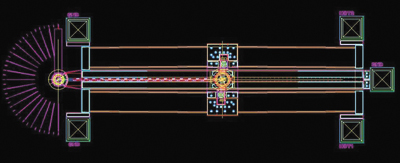
Another major student contest in the microworld ended with microelectromechanical systems (MEMS) designs from the University of Oklahoma and University of Illinois chosen as winners in Sandia’s fourth annual University Alliance Design Competition.
The University of Oklahoma, under the leadership of faculty advisor Harold Stalford, won the “Novel Design” category for a mechanical micromuscle powered by thermal actuators that allow a mechanical arm to operate with nanoscale functionality above, to the side of, and in the plane of its operating chip.
The potential applications of the microrobotic arm include microsurgical operations and assembly of 3-D MEMS devices.
The device’s thermal actuators require less voltage than similar devices (usually not capable of such precise movement) that rely upon electrostatic actuators.
To demonstrate their functionality, the newly designed components were placed as a tool on the operating platform designed last year at the university.
The student team from the University of Illinois at Urbana-Champaign, under the leadership of Professor Ioannis Chasiotis, won in the “Characterization, Reliability, and Nanoscale Phenomenon” category by creating a design for the first MEMS platform able to perform creep and stress relaxation tests on polymeric, metallic, and biological nanofibers.
The components are designed to test time-dependent behavior at even submicroNewton force levels on polymeric and biological nanofibers, and to report in “real time”— that is, as the changes occur.
Thermal grips mounted on a comb-drive actuator generate a predetermined amount of sample deformation, adding to the device’s accuracy.
First-place winners (student lead and sponsoring professor) in both categories were invited to visit
Sandia to present their design to Sandia’s review team, meet with MEMS experts, and tour Sandia’s MEMS facilities. All other participants were welcome to attend the awards ceremony and present their design, pending Sandia technical approval.
Participation in the alliance now stands at 20 schools, up from 17 a year ago. This year, five schools entered seven designs in the contest. An incentive for universities to join the Alliance is that all contest participants can actually see their workable designs made flesh (or at least, silicon) in Sandia’s MEMS production facilities, where “a special design competition reticle is set aside for just this purpose,” says Mark Platzbecker, technical team lead in Sandia’s MEMS Core Technologies Dept. 1749-1.
Fabrication of the student designs is expected to start by June 15, with parts emerging from the fab by Sept. 15, he says.
Another plus this year included utilization of the new MESA facilities in Bldg. 858EL, says Mark. “This greatly increased the collaborative nature of the Sandia and university interactions. We were able for the first time to create high-end interactive digital discussions and reviews.”
View downloadable images of the winning designs from this website.
For more information regarding the contest, or to learn how an educational institution can become a member of the University Alliance, contact Stephanie Johnson at srjohns@sandia.gov.
Further information can be found here.